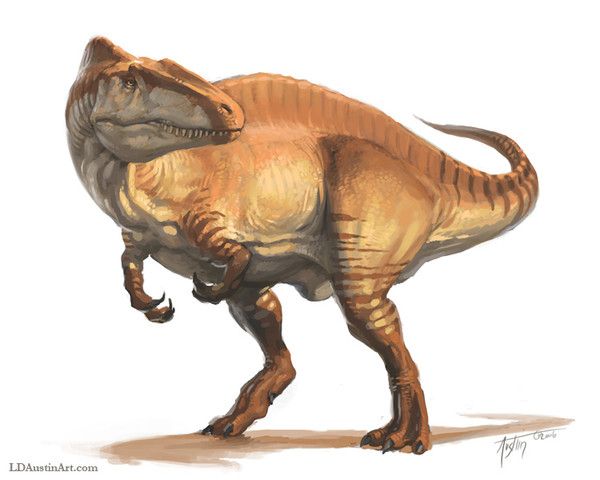Post by dinosauria101 on Apr 12, 2019 3:14:55 GMT 5
Acrocanthosaurus atokensis
Acrocanthosaurus is a genus of theropod dinosaur that existed in what is now North America during the Aptian and early Albian stages of the Early Cretaceous. Like most dinosaur genera, Acrocanthosaurus contains only a single species, A. atokensis. Its fossil remains are found mainly in the U.S. states of Oklahoma, Texas, and Arkansas, although teeth attributed to Acrocanthosaurus have been found as far east as Maryland. Acrocanthosaurus was a bipedal predator. As the name suggests, it is best known for the high neural spines on many of its vertebrae, which most likely supported a ridge of muscle over the animal's neck, back and hips. Acrocanthosaurus was one of the largest theropods, approaching 12 meters (40 ft) in length, and weighing up to 6.2 metric tons (6.8 short tons). Large theropod footprints discovered in Texas may have been made by Acrocanthosaurus, although there is no direct association with skeletal remains. Recent discoveries have elucidated many details of its anatomy, allowing for specialized studies focusing on its brain structure and forelimb function. Acrocanthosaurus was the largest theropod in its ecosystem and likely an apex predator which possibly preyed on large sauropods and ornithopods. The largest known specimen (NCSM 14345) is estimated to have measured 11.5 m (38 ft) from snout to tail tip and weighed 5.7 to 6.2 metric tons (6.3 to 6.8 short tons), with an upper maximum weight of 7.25 metric tons (7.99 short tons) within the realm of possibility for this specimen.

Utahraptor ostrommaysorum (pack of 12)
Utahraptor (meaning "Utah's predator" or "Utah thief") is a genus of theropod dinosaurs, including the largest known members of the family Dromaeosauridae. Fossil specimens date to the upper Barremian stage of the early Cretaceous period (in rock strata dated to 126 ± 2.5 million years ago). It contains a single species, Utahraptor ostrommaysorum. The holotype specimen of Utahraptor is fragmentary, consisting of skull fragments, a tibia, claws and some caudal (tail) vertebra. These few elements suggest an animal about twice the size of Deinonychus. Like other dromaeosaurids, Utahraptor had large curved claws on their second toes. One claw specimen is preserved at 22 centimetres (8.7 in) in length and is thought to reach 24 centimetres (9.4 in) restored. The largest described U. ostrommaysorum specimens are estimated to have reached up to 7 m (23 ft) long and somewhat less than 500 kg (1,100 lb) in weight, comparable to a grizzly bear in size. Some undescribed specimens in the BYU collections may have reached up to 11 m (36 ft) long, though these await more detailed study.

Credit to Wikipedia
Acrocanthosaurus is a genus of theropod dinosaur that existed in what is now North America during the Aptian and early Albian stages of the Early Cretaceous. Like most dinosaur genera, Acrocanthosaurus contains only a single species, A. atokensis. Its fossil remains are found mainly in the U.S. states of Oklahoma, Texas, and Arkansas, although teeth attributed to Acrocanthosaurus have been found as far east as Maryland. Acrocanthosaurus was a bipedal predator. As the name suggests, it is best known for the high neural spines on many of its vertebrae, which most likely supported a ridge of muscle over the animal's neck, back and hips. Acrocanthosaurus was one of the largest theropods, approaching 12 meters (40 ft) in length, and weighing up to 6.2 metric tons (6.8 short tons). Large theropod footprints discovered in Texas may have been made by Acrocanthosaurus, although there is no direct association with skeletal remains. Recent discoveries have elucidated many details of its anatomy, allowing for specialized studies focusing on its brain structure and forelimb function. Acrocanthosaurus was the largest theropod in its ecosystem and likely an apex predator which possibly preyed on large sauropods and ornithopods. The largest known specimen (NCSM 14345) is estimated to have measured 11.5 m (38 ft) from snout to tail tip and weighed 5.7 to 6.2 metric tons (6.3 to 6.8 short tons), with an upper maximum weight of 7.25 metric tons (7.99 short tons) within the realm of possibility for this specimen.

Utahraptor ostrommaysorum (pack of 12)
Utahraptor (meaning "Utah's predator" or "Utah thief") is a genus of theropod dinosaurs, including the largest known members of the family Dromaeosauridae. Fossil specimens date to the upper Barremian stage of the early Cretaceous period (in rock strata dated to 126 ± 2.5 million years ago). It contains a single species, Utahraptor ostrommaysorum. The holotype specimen of Utahraptor is fragmentary, consisting of skull fragments, a tibia, claws and some caudal (tail) vertebra. These few elements suggest an animal about twice the size of Deinonychus. Like other dromaeosaurids, Utahraptor had large curved claws on their second toes. One claw specimen is preserved at 22 centimetres (8.7 in) in length and is thought to reach 24 centimetres (9.4 in) restored. The largest described U. ostrommaysorum specimens are estimated to have reached up to 7 m (23 ft) long and somewhat less than 500 kg (1,100 lb) in weight, comparable to a grizzly bear in size. Some undescribed specimens in the BYU collections may have reached up to 11 m (36 ft) long, though these await more detailed study.

Credit to Wikipedia




